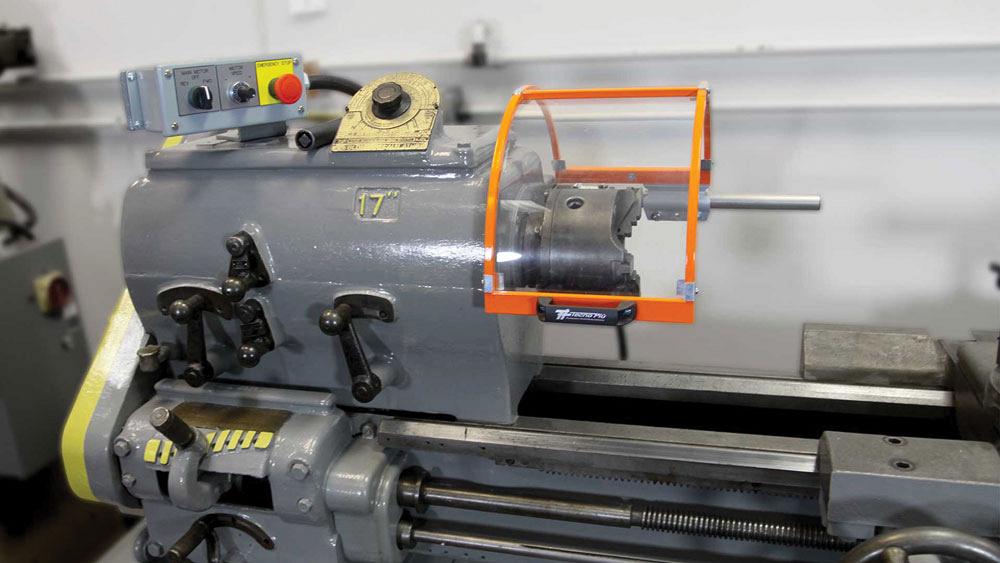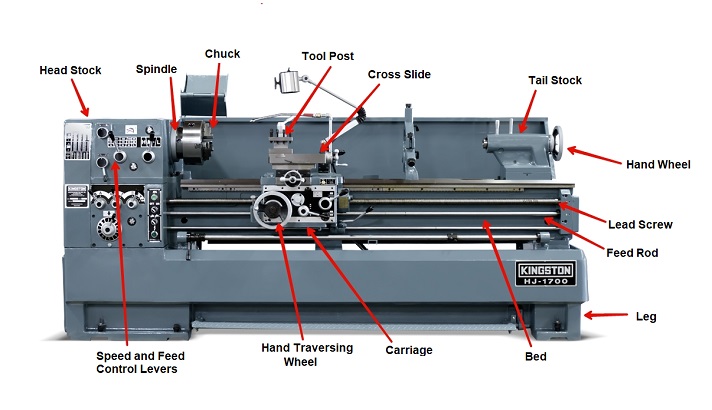Are you curious to know what a conventional lathe can’t do? Well, you’ve come to the right place! In this article, we’re going to explore the limitations of a conventional lathe and discover what tasks it just can’t handle. So, fasten your seatbelt and get ready for an exciting journey into the world of machining!
Picture this: a conventional lathe, a powerful machine that can shape metal with precision and finesse. But alas, even this mighty tool has its limits. While a conventional lathe can perform a wide range of operations, there are certain tasks that are beyond its capabilities. So, buckle up and let’s dive into the realm of what a conventional lathe simply can’t do!
As we delve deeper, we’ll uncover the secrets of what lies outside the conventional lathe’s realm. From intricate internal threading to complex milling operations, we’ll explore the fascinating world of machining that requires specialized tools beyond the humble lathe. So, are you ready to expand your knowledge and discover the boundaries of what can’t be done on a conventional lathe? Let’s embark on this exciting journey together!
Conventional lathes have limitations in terms of the shapes and sizes they can handle. While they are great for cylindrical shapes, there are certain things they cannot do. For example, they cannot produce intricate, complex designs or perform asymmetrical machining. Additionally, conventional lathes are not ideal for working on large or heavy workpieces, and they may not have the capability to perform advanced operations like threading or tapping. Understanding these limitations can help users determine when alternative machining methods are necessary.

What Can Not be Done on a Conventional Lathe?
A conventional lathe is a versatile machine used for various machining operations. However, there are certain limitations to what can be done on a conventional lathe. In this article, we will explore these limitations and understand what tasks cannot be accomplished with this type of lathe. We will delve into the reasons behind these limitations and explore alternative methods to achieve the desired results.
1) Non-Rotational Symmetrical Shapes
One of the main limitations of a conventional lathe is its inability to create non-rotational symmetrical shapes. A lathe operates by rotating the workpiece on its axis while a cutting tool is applied to shape it. This rotational movement limits the type of shapes that can be produced. Complex geometries, such as irregular polygons or curved surfaces that do not maintain rotational symmetry, cannot be achieved on a conventional lathe.
To overcome this limitation, other machining processes such as milling, grinding, or 3D printing can be employed. These methods allow for more intricate and complex shapes to be formed, including non-rotational symmetrical ones.
2) Large Workpieces
Another limitation of a conventional lathe is the size of the workpiece it can accommodate. The chuck or spindle of a lathe has a limited diameter, which restricts the size of the workpiece that can be mounted and machined. Large and bulky workpieces that exceed the lathe’s capacity cannot be effectively processed on a conventional lathe.
In such cases, specialized machines like vertical boring mills or horizontal machining centers are used to handle larger workpieces. These machines offer a bigger work envelope and the necessary rigidity to handle heavy and oversized components.
3) Internal Threads
While a conventional lathe is efficient in cutting external threads, it has limitations when it comes to creating internal threads. Since the lathe is centered around rotating the workpiece, it becomes challenging to create precise internal threads due to limited access and interference with the cutting tool.
To generate internal threads, other machining methods such as tapping, die cutting, or thread milling are commonly used. These processes allow for the creation of accurate internal threads without the limitations imposed by a conventional lathe.
4) Machining Hardened Materials
Conventional lathes are generally not suitable for machining hardened materials due to the limitations of their cutting tools. The cutting tools used in lathes are usually made of high-speed steel (HSS) or carbide, which have their respective cutting speed and material hardness limits. When it comes to hardened materials, such as hardened steel or hardened alloys, these cutting tools may wear out quickly or become damaged.
To overcome this limitation, specialized machining methods like hard turning or grinding are utilized. These methods employ dedicated tools and techniques to effectively machine hardened materials without compromising the quality and integrity of the cutting tools.
5) High-Precision Machining
Although a conventional lathe can achieve respectable precision, it has limitations when it comes to high-precision machining. The accuracy and repeatability of a lathe are influenced by various factors such as machine condition, tool wear, and inherent limitations in the design and construction of the machine.
For applications requiring extremely high precision, dedicated machines like CNC lathes or machining centers are used. These machines incorporate advanced control systems, linear guideways, and high-precision spindles to achieve the level of precision demanded by the application.
6) Complex Milling Operations
While a conventional lathe can perform some basic milling operations, it is not designed for complex milling tasks. Milling involves cutting or shaping materials using a rotating milling cutter. A lathe’s primary function is to rotate the workpiece, making it difficult to achieve the necessary movements and control required for intricate milling operations.
To carry out complex milling operations, milling machines like vertical mills or horizontal mills are utilized. These machines are specifically designed to provide the necessary rigidity, precision, and versatility required for milling operations.
7) Multi-Axis Machining
Conventional lathes are limited to two axes of movement: the X-axis (longitudinal) and the Z-axis (cross-feed). This restricts the capability of the lathe to create complex geometries that require additional axes of movement.
For multi-axis machining tasks, CNC machines with multiple axes, such as 3-axis or 5-axis machines, are used. These machines offer enhanced maneuverability, allowing for the creation of intricate and complex shapes that are not achievable on a conventional lathe.
Key Takeaways: What Can Not Be Done on a Conventional Lathe?
- A conventional lathe cannot perform complex milling operations.
- It is not suitable for threading operations.
- Precision grinding cannot be done on a conventional lathe.
- Conventional lathes cannot handle large or heavy workpieces.
- It is not capable of performing multi-axis machining.
Frequently Asked Questions
Welcome to our FAQ section on what can or cannot be done on a conventional lathe. Here, we’ll address common queries related to the limitations of these machines and help you gain a better understanding of their capabilities and boundaries. Let’s dive in!
What are some tasks that cannot be performed on a conventional lathe?
While a conventional lathe is a versatile machine, there are certain tasks it cannot handle. For example, complex contouring and intricate 3D profiling might pose a challenge for a conventional lathe. These machines are primarily designed for cylindrical turning and facing operations, so tasks that require high precision and intricate detailing are better suited for specialized equipment like CNC lathes or milling machines.
Moreover, conventional lathes are not ideal for cutting hardened or tough materials. The cutting forces involved in such operations can put excessive strain on the machine and lead to inaccuracy or damage. For such materials, it’s recommended to use a lathe with higher horsepower and rigidity, such as a heavy-duty lathe or a lathe specifically designed for cutting hard materials.
Can a conventional lathe be used for thread cutting?
Yes, a conventional lathe can be used for thread cutting. In fact, this is one of the primary operations for which lathes are commonly used. With the right tooling and setup, you can cut both external (male) and internal (female) threads on a conventional lathe. However, it’s important to note that the range of threads that can be cut on a conventional lathe is limited in comparison to dedicated thread cutting machines. For intricate or specialized threads, it may be more efficient to use a dedicated thread cutting machine.
Additionally, when using a conventional lathe for thread cutting, you need to be mindful of the leadscrew’s pitch and the appropriate gear ratio to match the desired thread pitch. It’s important to refer to the lathe’s user manual or consult an expert to ensure accurate and consistent thread cutting results.
Is it possible to perform milling operations on a conventional lathe?
While a conventional lathe is primarily designed for turning operations, it is possible to perform some milling operations on it. This process is known as “milling on the lathe” or “milling in the lathe.” With the help of a milling attachment or a milling slide, you can perform simple milling tasks like slotting, grooving, or keyway cutting on a conventional lathe. However, it’s important to note that the precision and versatility of milling on a lathe are limited compared to dedicated milling machines.
If you require complex milling operations or a high level of precision, it’s recommended to use a dedicated milling machine. These machines are specifically designed for milling tasks and offer more features, stability, and accuracy than a conventional lathe. Nevertheless, for simple or occasional milling tasks, utilizing a lathe with a milling attachment can be a viable option.
Can a conventional lathe be used for woodturning?
Yes, a conventional lathe can indeed be used for woodturning. In fact, woodturning is one of the popular applications of a conventional lathe. With the appropriate tooling and techniques, you can create beautiful turned wooden objects such as bowls, spindle-shaped items, or even intricate decorative designs on a conventional lathe. However, it’s important to ensure the lathe is properly set up and the necessary safety precautions are followed when working with wood.
It’s worth mentioning that specialized wood lathes with additional features like variable speed control, larger swing capacity, and specific accessories for woodturning are available in the market. These lathes offer greater convenience and flexibility for woodturning enthusiasts, but for beginners or occasional woodturning tasks, a conventional lathe can be a suitable choice.
Can a conventional lathe be used for internal drilling?
Yes, a conventional lathe can be used for internal drilling operations. With the appropriate tooling and setup, you can drill accurate and precise holes inside a workpiece using a conventional lathe. Internal drilling is commonly performed with the help of a drill chuck or drill bit holder attached to the lathe’s tailstock.
However, it’s important to consider the limitations of a conventional lathe for internal drilling. The depth and diameter of holes that can be drilled are restricted by the lathe’s bed length and swing capacity. For larger or deeper holes, or when drilling multiple holes at varying depths or angles, a dedicated drilling machine might be a more efficient and suitable choice.

Summary
On a conventional lathe, there are a number of things that cannot be done. First, you cannot make complex shapes or intricate designs because the lathe only moves in straight lines. Second, you cannot work with hard materials like steel or titanium because the lathe does not have enough power. Lastly, you cannot work on large or heavy objects because the lathe has a limited capacity.
However, there are alternative machines like CNC lathes that can do what conventional lathes cannot. These computer-controlled lathes can make complex shapes, work with hard materials, and handle large objects. So, although there are limitations with conventional lathes, there are other options to get the job done.
The post What Can Not Be Done On A Conventional Lathe? appeared first on The Habit of Woodworking.
source https://thehabitofwoodworking.com/2024/what-can-not-be-done-on-a-conventional-lathe/

No comments:
Post a Comment